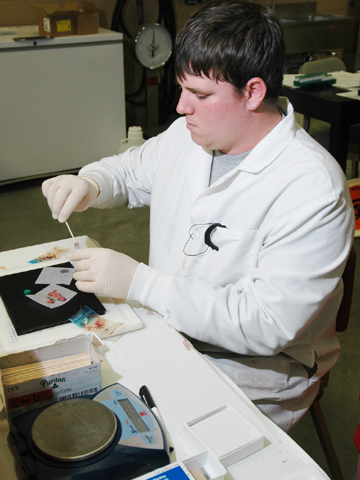| |
|
|

from the issue of January 6, 2005
|

| |
|
|
| |
Students help with testing of deer

BY SANDI ALSWAGER, IANR NEWS SERVICE
Deer season is over. That means it's crunch time for scientists and student workers at UNL's Veterinary Diagnostic Center.

| | 
 
| | | Josh Schmidt, a veterinary science major from Wymore, prepares a deer lymph node sample for testing.

|
For the past three years after deer hunting season, the diagnostic center had tested thousands of deer tissue samples for chronic wasting disease. To help with this flood of samples, about 20 undergraduate students, mostly from the College of Agricultural Sciences and Natural Resources, don white lab coats and work side-by-side with the center's staff to process samples.

Students get hands-on laboratory experience, a better understanding of science and a paycheck. The center gets much-needed help at a critical time, said David Steffen, the Institute of Agriculture and Natural Resources veterinary scientist who directs the center.

"I don't know how we'd meet the public's demand without the help of our students," Steffen said.

The center began testing more than 7,000 deer lymph node samples in November. Nebraska Game and Parks Commission officials collect lymph node samples from deer shot by hunters across the state.

After the lymph node samples arrive at the center, students must cut, weigh and process them into a liquid that is further processed by students before final analysis by the center's staff. The game and parks commission mails results to hunters.

Most of the activity in the lab happened in the afternoon after students had finished classes for the day.

Josh Schmidt, a junior veterinary science major from Wymore, said working in the lab is a good experience and something he can be put on his resume when he searches for a job after graduation.

"It's a good job environment," said Laura Safarick, a junior environmental studies major from Lincoln who also worked at the center last year. She added that because of the center's reputation for prompt and efficient service, Arizona opted to send its samples to Nebraska this year.

It's also a service for Nebraska hunters, Steffen said.

"This isn't a procedure that we offer year round," he said. Testing continues through early January. "Since (rifle) deer hunting season is nine days long in Nebraska, we get all of the samples at once following deer hunting season.

"Hunters want to know, so we try to get their results to them as fast as possible. Although there is no human connection to CWD, people still do not want to eat the meat from animals that had the disease."

CWD is a degenerative neurological disease in deer and elk in North America. It is similar to bovine spongiform encephalopathy, or mad cow disease, in cattle.

This year, the center received about 5,800 samples from Nebraska and roughly another 1,100 from Arizona.

As of mid-December Steffen expected 500 more Nebraska samples and another 800 samples from Arizona.

"Arizona has not had a positive test for CWD, but New Mexico had it last year so now Arizona is testing for it," Steffen said.

In Nebraska, 0.3 percent of deer test positive each year for CWD, which so far has been limited to the western part of the state.

There have been 14 suspect positives this year, Steffen said. After a sample tests positive, scientists test it again using a second method to ensure accuracy.

"This year a suspect positive has been found farther east in Nebraska than in previous years," Steffen said. "This information is important to the game and parks commission in helping monitor the disease."

A grant through the game and parks commission funds testing.
GO TO: ISSUE OF JANUARY 6
NEWS HEADLINES FOR JANUARY 6
Students help with testing of deer
3rd 'report card' highlights progress
731952S34078X
|
|
|
|
|
|
|
|